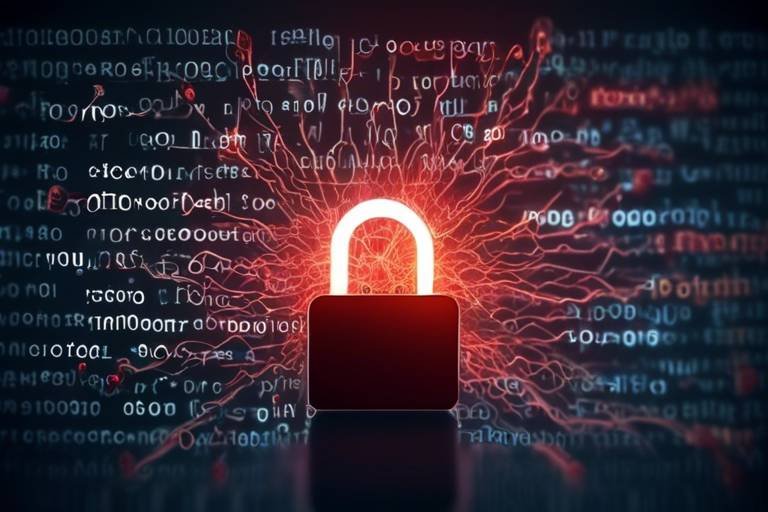The Future of Cybersecurity in a Digital World
Exploring the evolving landscape of cybersecurity, this article delves into emerging threats, innovative technologies, and strategies to safeguard our digital lives in an increasingly interconnected world. In today's fast-paced digital age, where everything from our personal information to critical business operations is online, the importance of cybersecurity cannot be overstated. With every click, swipe, and tap, we expose ourselves to potential risks that could have devastating consequences. So, how do we navigate this treacherous terrain? Let’s embark on this journey to understand the future of cybersecurity and what it holds for us.
As technology advances, so do the tactics of cybercriminals. Gone are the days when a simple virus was the primary concern. Today, we face a plethora of sophisticated threats that evolve at lightning speed. Ransomware, for instance, has become a household name, targeting individuals and organizations alike. Imagine waking up to find your files encrypted and a ransom note demanding payment in cryptocurrency. It's a nightmare scenario that has become all too common.
Phishing attacks are another prevalent threat, where cybercriminals masquerade as trustworthy entities to steal sensitive information. Think of it as a digital con artist, luring victims into a trap. Advanced Persistent Threats (APTs) add another layer of complexity, as they involve prolonged and targeted cyberattacks aimed at stealing information over time. These threats highlight the urgent need for robust cybersecurity measures to protect our digital lives.
New technologies are revolutionizing cybersecurity, from artificial intelligence to blockchain. These innovations are not just buzzwords; they are essential tools in enhancing threat detection and response capabilities. For instance, artificial intelligence (AI) is transforming the landscape by enabling predictive analytics, which helps organizations anticipate potential threats before they materialize. But how does this work?
AI tools are designed to identify vulnerabilities and mitigate risks in real-time. By analyzing patterns in data, AI can flag unusual behavior that may indicate a cyber threat. This proactive approach allows organizations to stay one step ahead of cybercriminals. Imagine having a security guard that never sleeps, constantly monitoring for potential breaches—that's the power of AI in cybersecurity.
Machine learning algorithms play a crucial role in improving threat detection accuracy. They analyze vast amounts of data to detect anomalies, significantly reducing false positives in cybersecurity systems. This means fewer unnecessary alerts and more focus on genuine threats. The ability to learn and adapt makes these algorithms invaluable in the fight against cybercrime.
AI-driven systems streamline incident response processes, enabling faster recovery from cyber incidents. When a breach occurs, time is of the essence. Automated responses can contain and mitigate damage, allowing organizations to bounce back quickly. Think of it as having a fire extinguisher ready when a fire breaks out—immediate action can save the day.
Blockchain technology offers unique advantages for cybersecurity, providing decentralized and tamper-proof data storage. Its potential applications in securing sensitive information and transactions are vast. By using blockchain, organizations can ensure that their data remains unaltered and accessible only to authorized users. This technology is like a vault that not only keeps your valuables safe but also ensures that no one can tamper with them.
As cyber threats grow, so do regulatory requirements. Organizations face significant challenges in maintaining compliance with regulations like GDPR and CCPA. These laws are designed to protect consumer data, but keeping up with them can be daunting. A robust security framework is essential for organizations to navigate this complex landscape.
Data privacy regulations are becoming increasingly stringent. Businesses must ensure compliance while protecting customer data, which can feel like walking a tightrope. Understanding the implications of these laws is crucial for maintaining trust and avoiding hefty fines.
Different industries face unique compliance standards. For example, the finance sector has stringent requirements to protect sensitive financial information, while healthcare organizations must comply with HIPAA regulations to safeguard patient data. Tailored cybersecurity strategies are vital for meeting these specific needs and ensuring that organizations remain compliant.
Human error remains a significant factor in cyber incidents. Many breaches occur due to a lack of awareness or training among employees. Therefore, fostering a culture of security within organizations is paramount. Cybersecurity awareness training equips employees with the knowledge to recognize threats and respond appropriately. Best practices include:
- Regular training sessions to keep staff updated on the latest threats.
- Simulated phishing attacks to test and improve employee awareness.
- Encouraging a proactive approach to reporting suspicious activities.
In conclusion, the future of cybersecurity is not just about technology; it's also about people. By investing in training and awareness, organizations can create a resilient defense against the ever-evolving cyber threats that loom over us.
1. What are the most common types of cyber threats?
The most common types of cyber threats include ransomware, phishing attacks, and advanced persistent threats (APTs). Each poses unique risks to individuals and organizations alike.
2. How can organizations protect themselves against cyber threats?
Organizations can protect themselves by implementing robust cybersecurity measures, including using advanced technologies like AI, conducting regular security audits, and providing cybersecurity awareness training to employees.
3. Why is cybersecurity awareness training important?
Cybersecurity awareness training is crucial because human error is often a significant factor in cyber incidents. Educating employees helps them recognize threats and respond appropriately, reducing the risk of breaches.
4. What role does AI play in cybersecurity?
AI plays a significant role in cybersecurity by enabling predictive analytics, automating incident response, and improving threat detection accuracy through machine learning algorithms.

Emerging Cyber Threats
As technology advances at a breakneck pace, so too do the tactics employed by cybercriminals. In our increasingly digital world, the threat landscape is evolving, making it crucial for individuals and organizations to stay informed about the latest dangers lurking online. From ransomware attacks that can cripple businesses overnight to sophisticated phishing schemes that prey on unsuspecting users, the implications of these threats are profound. Cybercriminals are not just targeting large corporations; they are also setting their sights on individuals, exploiting vulnerabilities in personal devices and online accounts.
One of the most alarming trends is the rise of Advanced Persistent Threats (APTs). These are long-term targeted attacks where an intruder gains access to a network and remains undetected for an extended period. APTs typically aim to steal sensitive information or disrupt critical operations, making them particularly dangerous for government agencies and large enterprises. The complexity and stealth of these attacks require robust security measures that can adapt to evolving tactics.
Ransomware, in particular, has surged in popularity among cybercriminals. Imagine waking up to find that all your important files have been encrypted, and the only way to regain access is to pay a hefty ransom. This scenario has become all too real for many businesses and individuals. According to recent statistics, ransomware attacks have increased by over 300% in the past year alone, with attackers demanding ransoms that can reach into the millions. This not only results in financial losses but also damages reputations and erodes trust.
Another significant threat is phishing, which has evolved from simple email scams to highly sophisticated attacks. Today’s phishing schemes often utilize social engineering tactics to trick users into revealing personal information or downloading malicious software. Cybercriminals may impersonate trusted brands or even colleagues, making it increasingly difficult to discern legitimate communications from fraudulent ones. A recent survey revealed that over 70% of organizations reported falling victim to phishing attacks in the last year, highlighting the urgent need for enhanced security awareness among employees.
Moreover, the rise of the Internet of Things (IoT) has introduced new vulnerabilities. With billions of connected devices, each one represents a potential entry point for cybercriminals. Many IoT devices lack adequate security measures, making them easy targets for exploitation. As we embrace smart homes and automated systems, we must also remain vigilant about the security implications of these technologies.
In summary, the landscape of emerging cyber threats is both alarming and complex. From ransomware and phishing to APTs and IoT vulnerabilities, the variety of attacks is expanding, necessitating a proactive approach to cybersecurity. Organizations must invest in advanced security measures, employee training, and robust incident response plans to mitigate these risks. As we navigate this digital age, staying informed and prepared is our best defense against the ever-evolving threats that seek to compromise our safety and security.
- What is ransomware? Ransomware is a type of malicious software that encrypts a victim's files, rendering them inaccessible until a ransom is paid to the attacker.
- How can I protect myself from phishing attacks? Always verify the sender's email address, avoid clicking on suspicious links, and use two-factor authentication whenever possible.
- What are Advanced Persistent Threats (APTs)? APTs are prolonged and targeted cyberattacks where an intruder gains unauthorized access to a network and remains undetected for a long period.
- Why are IoT devices vulnerable to cyberattacks? Many IoT devices lack strong security features, making them easy targets for hackers looking to exploit weaknesses.

Innovative Security Technologies
In today's fast-paced digital landscape, innovation is the name of the game, especially when it comes to cybersecurity. As cyber threats evolve, so too must our defenses. The rise of innovative security technologies is revolutionizing the way we protect our digital lives. From artificial intelligence to blockchain, these advancements are not just buzzwords; they are the backbone of a more secure future. Let's dive into how these technologies are enhancing our ability to detect, respond to, and ultimately prevent cyberattacks.
Artificial intelligence (AI) is like having a super-smart assistant that never sleeps. It's transforming cybersecurity by enabling predictive analytics and automated responses, allowing organizations to stay one step ahead of cybercriminals. Imagine AI as a vigilant guard dog that can sense danger before it even arrives. With AI tools, businesses can identify vulnerabilities and mitigate risks in real-time, significantly reducing the window of opportunity for attackers.
At the heart of AI in cybersecurity are machine learning algorithms. These algorithms analyze vast amounts of data to detect anomalies that a human might miss. Think of it like a seasoned detective who can spot a clue in a sea of evidence. By improving threat detection accuracy, machine learning reduces false positives, ensuring that security teams can focus on genuine threats rather than wasting time on irrelevant alerts. This capability is crucial in a world where every second counts during a potential breach.
When a cyber incident occurs, speed is of the essence. AI-driven systems streamline incident response processes, enabling organizations to recover faster from attacks. Imagine having a fire alarm that not only alerts you but also starts extinguishing the flames. Automated responses can contain threats, isolate affected systems, and even initiate recovery protocols without human intervention. This not only minimizes damage but also enhances the overall security posture of the organization.
Another groundbreaking technology making waves in cybersecurity is blockchain. This decentralized and tamper-proof data storage solution offers unique advantages for securing sensitive information and transactions. Picture it as a digital vault that is virtually impossible to break into. Blockchain's inherent characteristics make it ideal for protecting data integrity and ensuring that information remains unchanged during transmission. From securing financial transactions to protecting personal data, the potential applications of blockchain in cybersecurity are vast and varied.
As we embrace these innovative technologies, it’s essential to remember that they are tools to aid our efforts in creating a secure digital environment. While they significantly enhance our defenses, they should be complemented by a robust cybersecurity strategy that includes regular assessments, employee training, and compliance with industry standards.
- What is the role of AI in cybersecurity? AI helps in predicting threats and automating responses, making it easier to identify vulnerabilities and mitigate risks.
- How does machine learning improve threat detection? Machine learning algorithms analyze large datasets to find anomalies, improving the accuracy of threat detection and reducing false positives.
- What are the benefits of using blockchain in cybersecurity? Blockchain provides a decentralized and tamper-proof way to store and secure sensitive information, ensuring data integrity during transactions.
- Why is incident response important in cybersecurity? A quick incident response minimizes damage during a cyberattack and helps organizations recover faster.

Artificial Intelligence in Cybersecurity
Artificial Intelligence (AI) is rapidly reshaping the landscape of cybersecurity, acting as a powerful ally in the ongoing battle against cyber threats. Imagine having a digital bodyguard that never sleeps, constantly analyzing vast amounts of data to identify potential vulnerabilities before they can be exploited. This is the promise of AI in cybersecurity. By leveraging predictive analytics and automated responses, organizations can proactively defend against attacks, rather than merely reacting to them.
One of the most significant advantages of AI is its ability to process and analyze data at a scale and speed that is simply unattainable for human analysts. For instance, AI algorithms can sift through millions of logs, pinpointing unusual patterns that may indicate a security breach. This capability not only enhances the speed of threat detection but also significantly reduces the chances of false positives—where legitimate activities are mistakenly flagged as threats. In a world where every second counts, this speed and accuracy can make all the difference.
Moreover, AI tools are evolving to include machine learning algorithms that continuously improve their performance over time. These algorithms learn from past incidents, adapting their detection techniques to stay one step ahead of cybercriminals. As they encounter new threats, they refine their processes, enhancing their ability to identify anomalies and respond accordingly. This self-learning aspect of AI is akin to having a cybersecurity expert on your team who gains experience and insight with every encounter.
Another exciting development is the implementation of AI-driven incident response systems. When a potential threat is detected, these systems can automatically initiate a response protocol, isolating affected systems and mitigating damage before human intervention is even required. This not only speeds up recovery times but also allows human cybersecurity teams to focus on more complex tasks that require critical thinking and creativity. The synergy between AI and human expertise creates a fortified defense mechanism that is crucial in today’s digital landscape.
To illustrate the impact of AI in cybersecurity, consider the following table that highlights key benefits:
| Benefit | Description |
|---|---|
| Enhanced Threat Detection | AI can analyze data in real-time, identifying threats faster than traditional methods. |
| Reduced False Positives | Machine learning improves accuracy, minimizing the chances of legitimate activities being flagged as threats. |
| Automated Responses | AI can initiate pre-set responses to threats, allowing for immediate action without human delay. |
| Continuous Learning | AI systems adapt and improve over time, becoming more effective against evolving threats. |
In conclusion, the integration of AI into cybersecurity strategies is not just a trend; it’s a necessity in our increasingly complex digital world. As cyber threats become more sophisticated, organizations that harness the power of AI will be better equipped to protect their sensitive data and maintain the trust of their customers. The future of cybersecurity is here, and it’s powered by artificial intelligence.
- What is AI in cybersecurity? AI in cybersecurity refers to the use of artificial intelligence technologies to enhance threat detection, response, and overall security measures.
- How does AI improve threat detection? AI analyzes vast amounts of data quickly to identify unusual patterns and potential threats, significantly improving detection speed and accuracy.
- Can AI completely replace human cybersecurity experts? No, while AI can automate many processes, human expertise is still essential for complex decision-making and strategy development.
- What are the risks of using AI in cybersecurity? Potential risks include reliance on automated systems that may overlook nuanced threats and the possibility of adversaries using AI for malicious purposes.

Machine Learning Algorithms
In the realm of cybersecurity, are becoming indispensable tools that are reshaping how we detect and respond to threats. These algorithms are designed to analyze vast amounts of data and identify patterns that would be nearly impossible for human analysts to discern. Imagine sifting through a mountain of documents; it would take an eternity to find a single grain of sand. However, machine learning algorithms can process this data in mere seconds, highlighting anomalies that may indicate a security breach.
One of the most significant advantages of machine learning in cybersecurity is its ability to improve threat detection accuracy. Traditional cybersecurity measures often rely on predefined rules to identify threats, which can lead to numerous false positives—alerts for threats that don’t actually exist. However, machine learning algorithms continuously learn from new data, adapting to evolving threats and becoming more precise over time. This adaptability is crucial in a landscape where cybercriminals are constantly refining their tactics.
To illustrate this, consider the following table that highlights key differences between traditional methods and machine learning approaches in threat detection:
| Aspect | Traditional Methods | Machine Learning Algorithms |
|---|---|---|
| Data Processing | Rule-based, limited scope | Dynamic, learns from data |
| False Positives | High rate | Reduced rate |
| Adaptability | Static | Self-learning |
| Speed of Detection | Slower | Faster |
Furthermore, machine learning algorithms can enhance incident response strategies. By leveraging predictive analytics, these algorithms can anticipate potential threats before they materialize. This proactive approach allows organizations to implement defensive measures ahead of time, minimizing the impact of potential attacks. For example, if a machine learning model detects unusual login patterns that deviate from the norm, it can automatically trigger alerts or even lock down accounts until further investigation is conducted.
In summary, the integration of machine learning algorithms into cybersecurity frameworks is not just a trend; it's a necessity in today's digital world. As cyber threats grow more sophisticated, organizations must embrace these technologies to stay one step ahead of cybercriminals. The future of cybersecurity will undoubtedly rely on the ability to harness the power of machine learning, transforming how we protect our digital assets.
- What are machine learning algorithms? Machine learning algorithms are systems that can learn from data, identify patterns, and make decisions with minimal human intervention.
- How do machine learning algorithms improve cybersecurity? They enhance threat detection accuracy, reduce false positives, and enable faster incident response by learning from new data.
- Can machine learning algorithms prevent cyber attacks? While they cannot prevent attacks entirely, they significantly improve the chances of detecting and mitigating threats before they escalate.

AI-Driven Incident Response
In today's fast-paced digital landscape, the speed at which cyber threats evolve is nothing short of astonishing. Traditional methods of incident response often struggle to keep up, leaving organizations vulnerable to devastating attacks. This is where comes into play, revolutionizing how businesses tackle security breaches. Imagine having a virtual assistant that not only detects anomalies in real-time but also takes immediate action to mitigate risks—this is the promise of AI in cybersecurity.
One of the most significant advantages of AI-driven systems is their ability to process vast amounts of data at lightning speed. While human analysts can only sift through so much information before fatigue sets in, AI algorithms can continuously monitor network traffic, user behavior, and system logs. This constant vigilance allows for the rapid identification of potential threats, enabling organizations to respond before a breach escalates. For instance, if an unusual login attempt is detected, AI can automatically initiate a series of predefined protocols, such as locking the account or alerting the security team.
Moreover, AI enhances the incident response process through automation. By automating routine tasks, security teams can focus on more complex issues that require human judgment. For example, when a phishing email is identified, AI can automatically quarantine the email, notify the affected user, and even initiate a follow-up investigation to determine if any sensitive information was compromised. This not only speeds up the response time but also reduces the likelihood of human error, which remains a significant factor in many cyber incidents.
Furthermore, AI-driven systems are equipped with predictive analytics capabilities. By analyzing historical data and identifying patterns, these systems can forecast potential threats before they materialize. This proactive approach allows organizations to strengthen their defenses and implement preventive measures, rather than merely reacting to incidents as they occur. For example, if the system detects a surge in login attempts from a specific geographical location, it can trigger alerts and prompt further investigation to determine if this is a precursor to a larger attack.
As we look ahead, the integration of AI in incident response is set to become even more sophisticated. With advancements in machine learning, these systems will continue to learn from past incidents, improving their accuracy and efficiency over time. Organizations that adopt AI-driven incident response will not only enhance their security posture but also gain a competitive edge in an increasingly hostile cyber environment.
In conclusion, the future of cybersecurity lies in the hands of AI-driven incident response systems. By embracing these technologies, organizations can not only respond to incidents more effectively but also foster a culture of security that prioritizes proactive measures. As cyber threats continue to evolve, leveraging AI will be essential in staying one step ahead of cybercriminals.
- What is AI-driven incident response?
AI-driven incident response refers to the use of artificial intelligence technologies to detect, analyze, and respond to cybersecurity incidents in real-time.
- How does AI improve incident response times?
AI improves incident response times by automating detection and response processes, allowing for faster identification and remediation of threats.
- Can AI replace human cybersecurity analysts?
While AI can automate many tasks, it cannot completely replace human analysts. Instead, it enhances their capabilities, allowing them to focus on more complex threats.
- What are the benefits of predictive analytics in cybersecurity?
Predictive analytics helps organizations anticipate potential threats by analyzing historical data, enabling proactive security measures.

Blockchain for Enhanced Security
In today's digital landscape, where data breaches and cyber threats loom large, blockchain technology emerges as a beacon of hope for enhancing security. At its core, blockchain is a decentralized ledger system that records transactions across many computers in such a way that the registered transactions cannot be altered retroactively. This unique feature not only ensures transparency but also significantly mitigates the risks associated with data tampering and fraud.
Imagine a world where every transaction you make online is securely logged in a way that is almost impossible to forge. This is the promise of blockchain. By utilizing cryptographic techniques, blockchain provides a robust framework for securing sensitive information. For instance, in industries like finance and healthcare, where data integrity is paramount, blockchain can offer a secure method for storing patient records or transaction histories. With blockchain, the need for a central authority is eliminated, which reduces the risk of a single point of failure.
Moreover, blockchain’s smart contracts feature allows for automated and self-executing agreements that are executed when certain conditions are met. This not only speeds up processes but also enhances security by removing intermediaries, which are often targets for cybercriminals. The transparency of these contracts ensures that all parties involved have visibility into the agreement, thus reducing the chances of disputes and fraud.
To illustrate the potential of blockchain in enhancing security, consider the following applications:
- Supply Chain Management: Blockchain can track the provenance of goods, ensuring that products are authentic and have not been tampered with.
- Identity Verification: By storing identity credentials on a blockchain, individuals can have greater control over their personal information, reducing the risk of identity theft.
- Financial Transactions: Blockchain can facilitate secure and transparent transactions, minimizing the risk of fraud and chargebacks.
Despite its many advantages, the adoption of blockchain technology is not without challenges. Issues such as scalability, energy consumption, and regulatory concerns need to be addressed. However, as the technology matures and more organizations recognize its potential, we can expect to see a significant shift towards blockchain-based solutions for enhancing cybersecurity.
In conclusion, blockchain technology represents a revolutionary approach to securing our digital transactions and sensitive information. By decentralizing data storage and employing advanced cryptographic techniques, blockchain not only enhances security but also fosters trust in an increasingly interconnected world. As we continue to navigate the complexities of cybersecurity, embracing innovative technologies like blockchain will be crucial in safeguarding our digital lives.
Q1: How does blockchain enhance security compared to traditional systems?
A1: Blockchain enhances security through decentralization, cryptographic techniques, and transparency, making it difficult for unauthorized parties to alter data.
Q2: Can blockchain be used for all types of data?
A2: While blockchain is versatile, it is best suited for data that requires high integrity and security, such as financial transactions and personal identity verification.
Q3: What are the main challenges of implementing blockchain technology?
A3: Key challenges include scalability, energy consumption, and regulatory compliance, which need to be addressed for wider adoption.
Q4: Is blockchain technology only for cryptocurrencies?
A4: No, blockchain technology has applications beyond cryptocurrencies, including supply chain management, identity verification, and secure voting systems.

Regulatory Challenges and Compliance
In today's digital landscape, the rise of cyber threats has prompted governments and organizations worldwide to implement stringent regulatory frameworks. These regulations, designed to protect sensitive information and maintain consumer trust, pose significant challenges for businesses striving to comply while also ensuring robust cybersecurity measures. The challenge lies not only in understanding the regulations but also in integrating them into existing security frameworks without disrupting daily operations. For instance, regulations like the General Data Protection Regulation (GDPR) and the California Consumer Privacy Act (CCPA) have set high standards for data privacy and protection, requiring organizations to rethink their data handling practices.
Compliance with these regulations is not just a legal obligation; it is also a crucial aspect of maintaining a competitive edge in the market. Companies that prioritize data protection can build stronger relationships with their customers, fostering loyalty and trust. However, the complexity of these regulations can be overwhelming. Organizations must navigate a web of requirements, including data breach notification protocols, user consent management, and the right to be forgotten. This can often result in significant financial and operational burdens, especially for smaller businesses that may lack the resources to implement comprehensive compliance strategies.
To effectively tackle these challenges, organizations should consider adopting a risk-based approach to compliance. By assessing their specific vulnerabilities and tailoring their security measures accordingly, businesses can better align their practices with regulatory requirements. Furthermore, investing in technology solutions that automate compliance processes can significantly reduce the burden on staff and minimize the risk of human error. For example, data management tools that track and manage customer consent can help ensure compliance with GDPR mandates while also streamlining operations.
Another critical aspect of regulatory compliance is the need for continuous monitoring and auditing. Regulations are not static; they evolve as new threats emerge and technology advances. Therefore, organizations must stay informed about changes in legislation and adjust their compliance strategies accordingly. Regular audits can help identify gaps in compliance and ensure that the organization is prepared for any potential regulatory scrutiny.
In conclusion, while the regulatory landscape can be daunting, it also presents an opportunity for organizations to strengthen their cybersecurity posture. By embracing compliance as a core component of their security strategy, businesses can not only protect themselves against cyber threats but also enhance their reputation and build trust with customers. It’s a win-win situation that can lead to long-term success in an increasingly interconnected world.
- What are the main regulations affecting cybersecurity? The main regulations include GDPR, CCPA, HIPAA, and PCI DSS, each focusing on different aspects of data protection and privacy.
- How can businesses ensure compliance? Businesses can ensure compliance by conducting regular risk assessments, implementing robust security measures, and staying informed about regulatory changes.
- What are the consequences of non-compliance? Non-compliance can lead to hefty fines, legal action, and reputational damage, which can severely impact a business's operations and customer trust.

Data Privacy Regulations
In today’s digital age, have become a cornerstone of cybersecurity. With the exponential growth of data generated by individuals and organizations, regulators worldwide are stepping in to establish frameworks that protect personal information. The implications of these regulations are profound, as they not only safeguard consumer data but also hold organizations accountable for their data handling practices. Imagine a world where your personal information is treated like a precious gem, carefully guarded and only shared with your consent. This is the vision that data privacy regulations aim to achieve.
Two of the most significant regulations shaping the landscape are the General Data Protection Regulation (GDPR) and the California Consumer Privacy Act (CCPA). The GDPR, enacted by the European Union, sets a high standard for data protection and privacy, granting individuals greater control over their personal data. It requires organizations to be transparent about how they collect, use, and store data. Non-compliance can lead to hefty fines, making it imperative for businesses to prioritize data protection.
On the other hand, the CCPA focuses specifically on the rights of California residents, allowing them to know what personal data is being collected, to whom it is being sold, and the right to access and delete that information. The CCPA has served as a model for other states in the U.S. looking to implement similar laws. However, navigating these regulations can be a daunting task for businesses, especially small and medium-sized enterprises that may lack the resources to fully comply.
Organizations must adopt a proactive approach to ensure compliance with these regulations. This includes conducting regular audits of data handling practices, implementing robust security measures, and fostering a culture of data privacy among employees. For instance, training staff on the importance of data privacy and how to handle sensitive information can significantly reduce the risk of breaches caused by human error. After all, a chain is only as strong as its weakest link.
Moreover, the evolving nature of data privacy regulations means that organizations need to stay informed about changes and updates. This can be likened to keeping up with a fast-paced race; if you fall behind, you risk losing not only your competitive edge but also your reputation. By investing in compliance frameworks and staying ahead of regulatory changes, businesses can not only protect themselves from potential fines but also build trust with their customers.
In conclusion, data privacy regulations are not just legal obligations; they are essential components of a comprehensive cybersecurity strategy. As we move further into a digital future, the importance of safeguarding personal information will only continue to grow. Organizations that embrace these regulations will not only comply with the law but also position themselves as leaders in data protection, fostering trust and loyalty among their customers.
- What is GDPR? The General Data Protection Regulation (GDPR) is a comprehensive data protection law in the EU that governs how personal data is processed and stored.
- What is CCPA? The California Consumer Privacy Act (CCPA) is a state statute that enhances privacy rights and consumer protection for residents of California.
- How can organizations ensure compliance? Organizations can ensure compliance by conducting audits, implementing security measures, and providing data privacy training to employees.
- What are the penalties for non-compliance? Non-compliance with data privacy regulations can result in significant fines and damage to a company’s reputation.

Industry-Specific Compliance Standards
In the ever-evolving landscape of cybersecurity, compliance standards vary significantly across different industries. This is largely due to the unique challenges and regulatory requirements that each sector faces. For instance, the healthcare industry is governed by the Health Insurance Portability and Accountability Act (HIPAA), which mandates strict guidelines for protecting patient information. On the other hand, the finance sector must adhere to the Gramm-Leach-Bliley Act (GLBA), which focuses on safeguarding consumer financial data. These regulations are not just bureaucratic hurdles; they are essential frameworks designed to protect sensitive information from cyber threats.
Understanding these industry-specific compliance standards is crucial for organizations aiming to bolster their cybersecurity posture. Failure to comply can result in hefty fines and damage to reputation. Moreover, as new technologies emerge and cyber threats evolve, regulations are becoming increasingly stringent. For example, the General Data Protection Regulation (GDPR) in Europe has set a high bar for data protection, requiring businesses to implement robust security measures and maintain transparency with customers regarding how their data is used.
To illustrate the differences in compliance standards across various industries, consider the following table:
| Industry | Key Regulation | Main Focus |
|---|---|---|
| Healthcare | HIPAA | Protection of patient health information |
| Finance | GLBA | Safeguarding consumer financial data |
| Retail | PCI DSS | Protection of payment card information |
| Technology | CCPA | Consumer privacy rights and data protection |
As you can see, each industry has its own set of compliance requirements tailored to address specific risks. For example, the Payment Card Industry Data Security Standard (PCI DSS) is critical for retailers, focusing on protecting payment card information from breaches. In contrast, the California Consumer Privacy Act (CCPA) emphasizes consumer rights in the tech industry, ensuring that users have control over their personal data.
Organizations must not only be aware of these regulations but also actively implement tailored cybersecurity strategies that align with them. This involves conducting regular risk assessments, employee training, and adopting advanced security technologies. By fostering a culture of compliance and security, businesses can significantly reduce their vulnerability to cyber threats while ensuring they meet regulatory expectations.
- What are industry-specific compliance standards?
These are regulations tailored to address the unique risks and requirements of specific industries, such as healthcare, finance, and technology. - Why is compliance important for cybersecurity?
Compliance helps organizations protect sensitive data, avoid legal penalties, and maintain customer trust. - How can businesses ensure compliance?
By conducting regular audits, providing employee training, and implementing appropriate security measures aligned with relevant regulations.

The Role of Cybersecurity Awareness Training
In today’s digital landscape, where cyber threats lurk at every corner, the significance of cybersecurity awareness training cannot be overstated. It’s not just about having the latest technology or sophisticated firewalls; it’s about empowering individuals within organizations to recognize and respond to cyber threats effectively. After all, as the saying goes, "a chain is only as strong as its weakest link." When employees are well-informed and trained, they become the first line of defense against potential attacks.
Imagine a scenario where a company invests heavily in cutting-edge cybersecurity tools but neglects to train its staff. This is akin to locking the front door while leaving the windows wide open. Cybercriminals often exploit human vulnerabilities, using tactics like phishing to trick unsuspecting employees into revealing sensitive information. Therefore, it's crucial for organizations to implement comprehensive training programs that educate their staff about the various types of cyber threats and the best practices for avoiding them.
Effective cybersecurity awareness training should cover a range of topics, including:
- Identifying Phishing Attempts: Employees should learn to spot suspicious emails and links that may lead to data breaches.
- Safe Browsing Practices: Training should include guidance on how to navigate the internet securely and recognize unsafe websites.
- Data Protection Protocols: Understanding how to handle sensitive information safely is vital.
- Incident Reporting: Employees must know how to report potential security incidents immediately.
Moreover, training should not be a one-time event. Cybersecurity threats are constantly evolving, and so should the knowledge of the workforce. Regular refresher courses and updates on the latest trends in cybersecurity can significantly enhance an organization’s security posture. Think of it as a sports team; continuous training and practice are essential to stay ahead of the competition. By fostering a culture of security awareness, organizations can create an environment where employees feel responsible for protecting sensitive data.
To further illustrate the impact of cybersecurity awareness training, consider the following statistics:
| Statistic | Impact |
|---|---|
| 90% of data breaches are caused by human error. | This highlights the need for effective training to mitigate risks. |
| Organizations with ongoing training programs reduce the risk of breaches by 70%. | Regular training significantly strengthens defenses. |
| Employees who receive training are 50% less likely to fall for phishing scams. | Informed employees make better decisions. |
In conclusion, cybersecurity awareness training is not just a checkbox on a compliance list; it is a vital component of an organization’s overall security strategy. By investing in training and fostering a culture of vigilance, organizations can dramatically reduce the risk of cyber incidents. Remember, in the realm of cybersecurity, knowledge truly is power.
Q1: How often should cybersecurity awareness training be conducted?
A1: Ideally, organizations should conduct training sessions at least once a year, with regular updates and refresher courses to keep employees informed about the latest threats.
Q2: What are some effective methods for delivering cybersecurity training?
A2: Training can be delivered through a variety of methods, including online courses, workshops, interactive simulations, and even gamified learning experiences to engage employees effectively.
Q3: How can organizations measure the effectiveness of their training programs?
A3: Organizations can assess the effectiveness of their training by conducting quizzes, surveys, and simulated phishing attacks to evaluate employee awareness and knowledge retention.
Frequently Asked Questions
- What are the most common emerging cyber threats today?
As technology evolves, cybercriminals are getting more sophisticated. The most common threats include ransomware, which locks users out of their data until a ransom is paid, phishing attacks that trick individuals into revealing sensitive information, and advanced persistent threats (APTs) that involve prolonged and targeted attacks on organizations.
- How does artificial intelligence enhance cybersecurity?
Artificial intelligence plays a crucial role in cybersecurity by enabling systems to analyze vast amounts of data quickly. With predictive analytics, AI can identify potential vulnerabilities before they are exploited. Moreover, it allows for automated responses to incidents, which can significantly reduce the time it takes to mitigate threats.
- What is the significance of blockchain in cybersecurity?
Blockchain technology offers a decentralized, tamper-proof way to store data, making it incredibly secure. Its ability to provide transparent transactions and protect sensitive information can help organizations safeguard against data breaches and fraud, creating a more secure digital environment.
- What are the key regulatory challenges organizations face?
Organizations often struggle to keep up with stringent regulations like GDPR and CCPA. These laws require businesses to implement robust security frameworks to protect customer data, making compliance a complex task that involves constant monitoring and updating of security measures.
- Why is cybersecurity awareness training important?
Human error is a leading cause of cyber incidents. By providing cybersecurity awareness training to employees, organizations can foster a culture of security. This training helps individuals recognize potential threats and understand best practices, ultimately reducing the risk of breaches caused by negligence.
- How can businesses ensure compliance with data privacy regulations?
To ensure compliance with data privacy regulations, businesses should conduct regular audits of their data handling practices, implement strong security measures, and stay informed about changes in the law. Additionally, they should invest in training their teams to understand the importance of data protection.
- What role do machine learning algorithms play in cybersecurity?
Machine learning algorithms are essential for improving threat detection accuracy. By analyzing large datasets, these algorithms can identify anomalies that may indicate a cyber threat, allowing for quicker responses and reducing the chances of false positives.



















